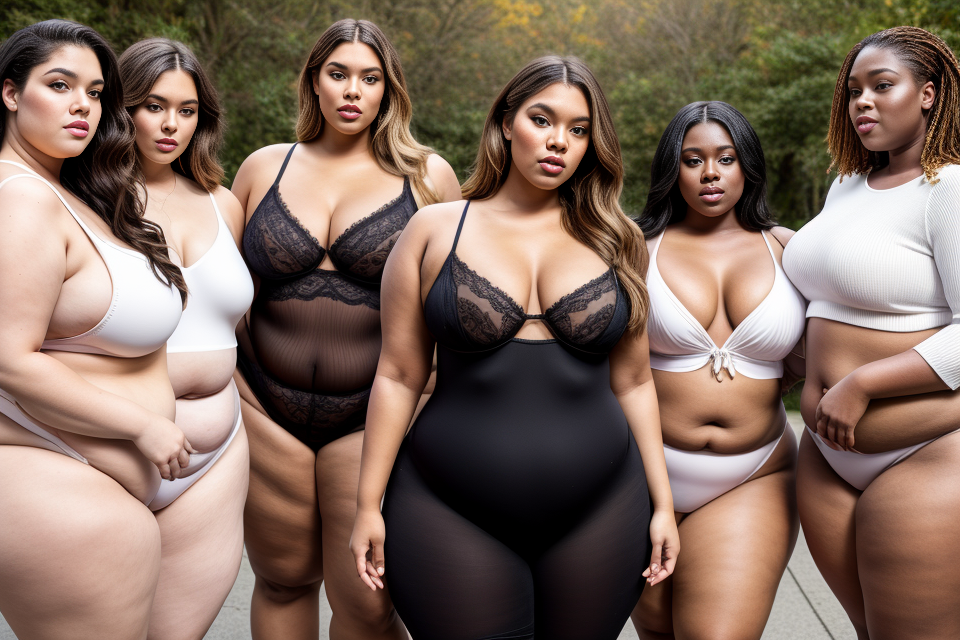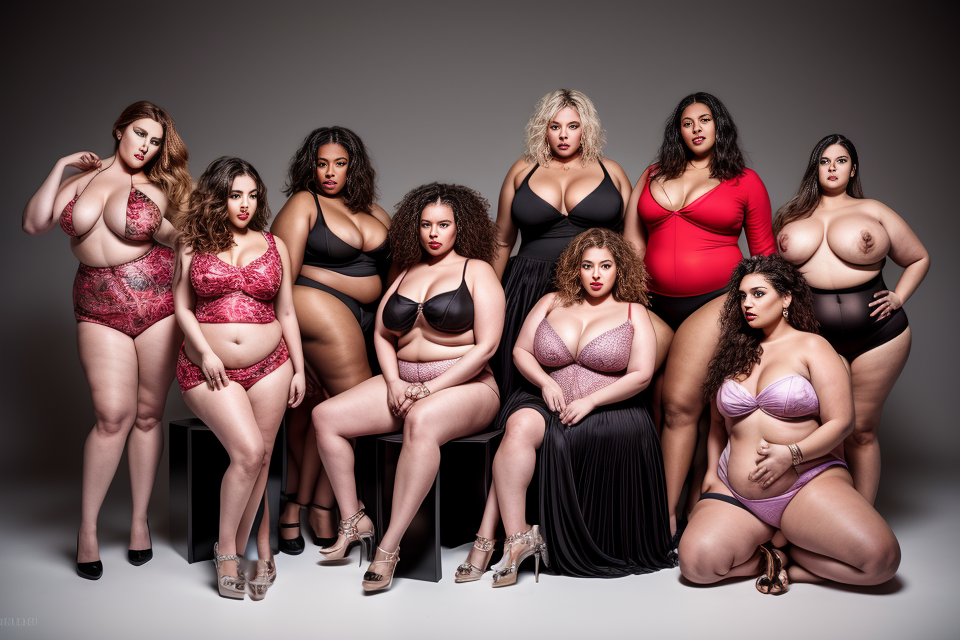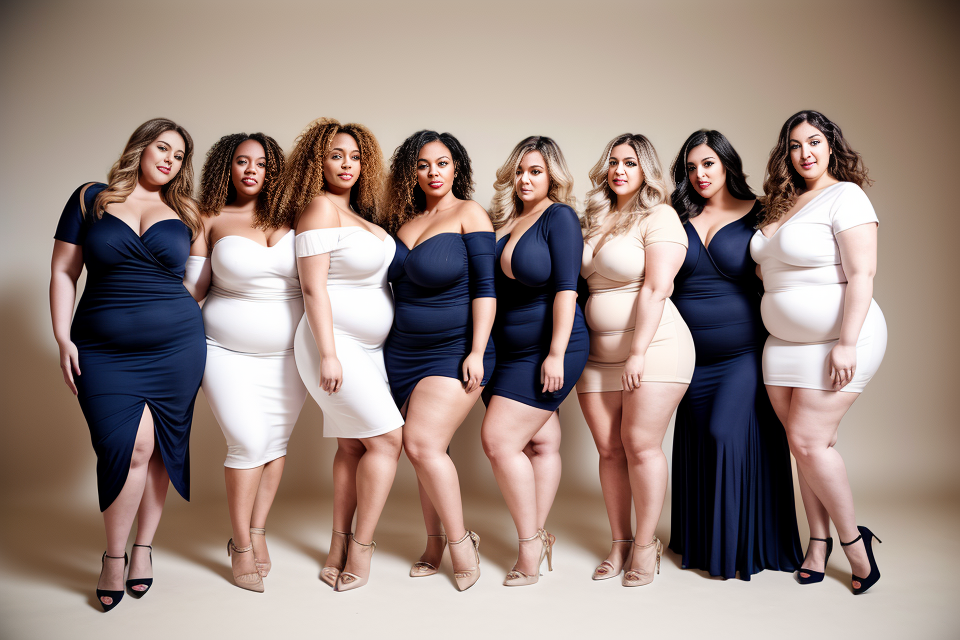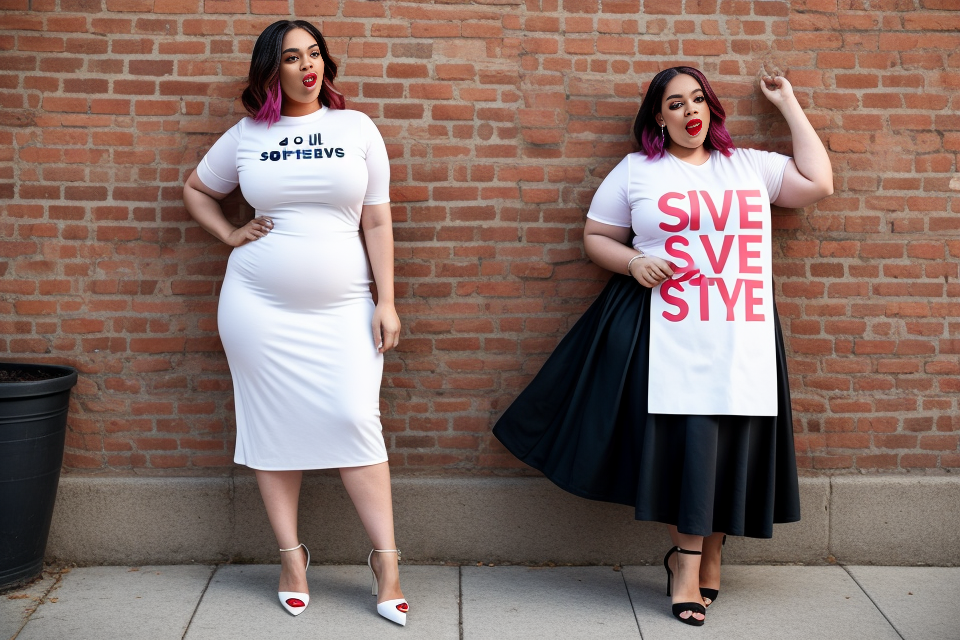
What is considered plus size? This is a question that has been asked by many individuals who struggle with body image and self-esteem. The answer, however, is not as simple as one might think. The fashion industry has its own set of standards when it comes to sizing, and these standards can vary greatly from one brand to another. In this comprehensive guide, we will explore the various factors that contribute to the definition of plus size, including body mass index (BMI), measurements, and industry standards. We will also discuss the importance of self-love and acceptance, regardless of size. So, let’s dive in and discover what it truly means to be considered plus size in the world of fashion.
The term “plus size” is often used to describe clothing sizes that are larger than the standard sizes offered by most retailers. The exact size range that is considered plus size can vary depending on the brand and the country, but generally it is used to describe sizes 14 and up in the United States. In the UK, the equivalent size range is typically 16 and up. It’s important to note that the plus size industry is continuing to grow and evolve, and there is a greater emphasis on inclusivity and body positivity, so more and more brands are offering a wider range of sizes and styles to cater to all body types.
Defining Plus Size: The Concept and Controversy
Historical Context of Plus Size
The term “plus size” has been used for many years to describe clothing that is designed for individuals who are larger than the standard size offered by most fashion retailers. The history of plus size clothing can be traced back to the early 20th century when the first plus size garments were introduced. These garments were designed for women who were considered to be overweight or obese by society’s standards at the time.
In the 1920s and 1930s, plus size clothing was marketed as “mature women’s” or “petite women’s” clothing, and it was not until the 1960s that the term “plus size” became widely used. During this time, the fashion industry began to recognize the need for clothing that would fit a wider range of body types, and plus size clothing became more widely available.
However, the term “plus size” has been the subject of controversy in recent years, with some arguing that it perpetuates negative body image and reinforces societal beauty standards. Critics argue that the term “plus size” implies that individuals who wear it are abnormal or deviant, and that it reinforces the idea that there is only one “normal” body type.
Despite these criticisms, the term “plus size” remains widely used in the fashion industry, and it is important for individuals who fall outside of the standard size range to have access to clothing that fits their bodies.
The Debate: At What Point Does a Person Become Plus Size?
The question of when a person becomes considered plus size is a subject of much debate. There is no universally agreed-upon definition of plus size, and what may be considered plus size in one context or culture may not be in another. Additionally, the definition of plus size can vary depending on the specific industry or sector. For example, in the fashion industry, the definition of plus size may be different from that in the healthcare industry.
One factor that complicates the definition of plus size is the issue of body size and shape. There is a wide range of body sizes and shapes that can be considered plus size, and the definition can vary depending on the specific measurement used. For example, some people may consider a person to be plus size if they wear a size 14 or above, while others may use a different cutoff point. Additionally, some people may consider a person to be plus size based on their weight, while others may focus more on body shape.
Another factor that can affect the definition of plus size is the context in which the term is used. For example, the definition of plus size may be different in the context of high fashion versus streetwear. In high fashion, the definition of plus size may be more restrictive, while in streetwear, it may be more inclusive.
Despite the lack of a universally agreed-upon definition, many people use the term plus size to describe individuals who wear sizes that are considered outside of the traditional or mainstream range of sizes. This can include sizes 14 and above, or sizes that are considered to be larger than the average size for a particular gender and age group.
Overall, the debate over when a person becomes considered plus size is complex and multifaceted. It is influenced by a range of factors, including cultural norms, industry standards, and individual definitions. As the conversation around body size and shape continues to evolve, it is likely that the definition of plus size will continue to be debated and refined.
Body Types and Plus Size
Different Body Types in Plus Size
When it comes to plus size fashion, it’s important to recognize that there is no one-size-fits-all approach to sizing. Different body types may require different sizes and fits, and it’s essential to understand these differences in order to find the right clothing that flatters your figure.
Here are some of the most common body types in plus size fashion:
- Apple shape: This body type is characterized by a larger upper body and smaller lower body. People with this shape may find that they have a smaller waist and larger hips, thighs, and arms.
- Pear shape: This body type is characterized by a larger lower body and smaller upper body. People with this shape may find that they have a larger waist and smaller hips, thighs, and arms.
- Hourglass shape: This body type is characterized by a balanced figure with similar measurements across the bust, waist, and hips. People with this shape may find that they have a defined waist and a curvaceous figure.
- Straight shape: This body type is characterized by a similar measurement across the bust, waist, and hips. People with this shape may find that they have a boyish or androgynous figure.
Understanding your body type can help you determine the right size and fit for your clothing. It’s important to take your measurements and use them as a guide when shopping for plus size clothing. Additionally, trying on clothes is crucial in finding the right fit, as different brands and styles may fit differently on different body types.
Factors That Influence Plus Size Clothing
When it comes to plus size clothing, there are several factors that can influence the sizing and fit of garments. Understanding these factors is crucial for ensuring that you purchase clothing that not only fits well but also flatters your body shape. In this section, we will discuss the various factors that can impact plus size clothing.
- Body Shape: One of the most significant factors that can influence plus size clothing is body shape. Different body shapes require different fits and styles. For example, a pear-shaped body may require a more fitted top and loose bottom, while an apple-shaped body may require a looser top and fitted bottom.
- Height: Another factor that can impact plus size clothing is height. Taller individuals may require longer lengths in their clothing, while shorter individuals may require shorter lengths. Additionally, taller individuals may require wider shoulder seams and shorter sleeves to avoid overwhelming their frame.
- Proportion: The proportion of one’s body can also impact the fit of plus size clothing. For example, individuals with larger arms may require a looser fit in the sleeve area, while those with larger hips may require a more fitted waistband.
- Lifestyle: Finally, one’s lifestyle can also impact the fit of plus size clothing. For example, an individual who is very active may require clothing that is more fitted for movement, while someone who is more sedentary may require looser, more comfortable clothing.
Understanding these factors can help you make informed decisions when purchasing plus size clothing. By taking your body shape, height, proportion, and lifestyle into consideration, you can find clothing that not only fits well but also makes you feel confident and comfortable.
Industry Standards for Plus Size Clothing
Sizing Charts in Plus Fashion
When it comes to plus size clothing, sizing charts play a crucial role in ensuring that customers purchase the right size for their body measurements. Sizing charts in plus fashion vary from one brand to another, but they generally follow industry standards that take into account the unique needs of plus-size individuals.
One important aspect of sizing charts in plus fashion is the use of vanity sizes. Unlike traditional clothing sizes, which often run small, plus size clothing sizes are designed to be more generous, with each size representing a wider range of body measurements. For example, a size 14 in plus fashion may correspond to a size 10 or 12 in traditional clothing sizes. This allows plus-size individuals to find clothing that fits them comfortably, without having to purchase items that are too small.
Another key feature of sizing charts in plus fashion is the use of measurements, rather than numerical sizes. This means that each size is defined by a specific set of measurements, such as waist size, bust size, and hip size. This approach ensures that individuals with different body shapes and measurements can find clothing that fits them properly, rather than relying on a single numerical size that may not be accurate for everyone.
In addition to using measurements, sizing charts in plus fashion may also include additional information, such as the length of sleeves and pants, to help customers make informed purchasing decisions. This information can be particularly helpful for individuals who have unique body proportions or preferences, such as those with long or short limbs.
Overall, sizing charts in plus fashion play a critical role in ensuring that individuals find clothing that fits them comfortably and confidently. By providing accurate measurements and taking into account the unique needs of plus-size individuals, sizing charts help to promote body positivity and inclusivity in the fashion industry.
Sizing Differences Between Brands
One of the biggest challenges when it comes to plus size fashion is the lack of standardization in sizing. Unlike traditional clothing sizes, which are based on a specific set of measurements, plus size clothing can vary significantly from brand to brand. This means that a size 16 in one brand might be equivalent to a size 20 in another brand, making it difficult for consumers to know what size to buy.
There are several reasons why sizing can differ so much between brands. One reason is that different brands have different body types in mind when they design their clothing. For example, some brands may cater to customers who are more curvy, while others may be geared towards those who are more hourglass-shaped. This means that a size 16 in one brand might be cut more loosely than a size 16 in another brand that is designed for a more curvy body type.
Another reason for the differences in sizing is that some brands use vanity sizing, which is the practice of labeling clothes with smaller sizes than they actually are. This is often done to make customers feel more confident about their bodies and to make the clothing appear more appealing. However, this can be confusing for customers who are used to traditional sizing and can lead to frustration when clothes don’t fit as expected.
To make matters worse, even within the same brand, sizing can vary between different styles and cuts of clothing. For example, a dress might be cut more loosely than a pair of pants with the same size label, so a customer who usually wears a size 16 in dresses might need to size down in pants to get the same fit.
Overall, the lack of standardization in plus size clothing sizing can make it difficult for customers to know what size to buy. It’s important to keep in mind that sizing can vary significantly between brands, and it’s always a good idea to check the brand’s size chart before making a purchase. Additionally, it’s a good idea to try on clothes in person whenever possible, as sizing can also vary between online retailers and brick-and-mortar stores.
Societal and Cultural Perceptions of Plus Size
Media Representation of Plus Size
The media has a significant impact on how society perceives and represents different body types. This section will examine how plus size individuals have been portrayed in various forms of media, including fashion, film, and television.
Fashion Industry
The fashion industry has traditionally been criticized for promoting a narrow and unrealistic standard of beauty, often resulting in the exclusion of individuals who do not fit within these norms. In recent years, there has been a growing movement towards more inclusive and diverse representation in fashion, with brands offering extended sizes and featuring plus size models in their campaigns.
However, the representation of plus size individuals in fashion media is still far from perfect. Many fashion brands continue to use thin models to showcase their clothing, which can perpetuate the idea that only certain body types are desirable or acceptable. Additionally, the limited representation of plus size individuals in fashion media often reinforces the notion that they are not considered “normal” or “mainstream.”
Film and Television
Plus size individuals have also been underrepresented in film and television. Historically, plus size characters have been portrayed as the “funny” or “undesirable” friend, or as characters who are overweight due to laziness or lack of self-control. This type of portrayal reinforces negative stereotypes and perpetuates the idea that plus size individuals are undesirable or less worthy of representation.
In recent years, there has been a shift towards more positive and realistic portrayals of plus size individuals in film and television. Shows like “Shrill” and “Pose” have featured plus size characters in lead roles, which has helped to challenge traditional beauty standards and promote more inclusive representation.
Overall, the media representation of plus size individuals has historically been limited and often negative. However, there has been a growing movement towards more inclusive and diverse representation in recent years, which offers hope for a more positive and accepting future.
Body Positivity and Acceptance of Different Sizes
Body positivity has gained significant traction in recent years, with people becoming more accepting of different body types. This shift in mindset has led to a greater understanding and appreciation of the diverse sizes that exist within the fashion industry. As a result, the term “plus size” has become more inclusive, encompassing a wider range of sizes than ever before.
Traditionally, the fashion industry has been dominated by a specific body type, which has often been considered the “ideal” or “normal” size. However, this has led to a lack of representation and inclusion for individuals who do not fit into this mold. Thankfully, there has been a growing movement towards body positivity and acceptance of different sizes, which has led to a more inclusive and diverse fashion industry.
One of the key drivers behind this movement has been the rise of social media platforms, which have provided a platform for individuals to share their stories and experiences. This has led to a greater understanding and appreciation of the diverse sizes that exist within the fashion industry, as well as a greater demand for inclusive sizing.
As a result, the fashion industry has begun to take notice, with many brands now offering extended sizes and catering to a wider range of body types. This has led to a greater variety of options for individuals who have traditionally been excluded from the fashion industry, allowing them to express their individuality and style in a way that was previously not possible.
In conclusion, the movement towards body positivity and acceptance of different sizes has led to a more inclusive and diverse fashion industry. As a result, the term “plus size” has become more inclusive, encompassing a wider range of sizes than ever before. This has led to a greater variety of options for individuals who have traditionally been excluded from the fashion industry, allowing them to express their individuality and style in a way that was previously not possible.
Resources for Plus Size Individuals
Finding the Right Clothes as a Plus Size Person
For plus size individuals, finding the right clothes can be a challenging task. It’s not always easy to find clothing that fits well, is comfortable, and looks good. However, with the right resources and knowledge, it is possible to find clothes that are both stylish and comfortable.
One important aspect of finding the right clothes is understanding the different sizing systems used by retailers. Many retailers use their own unique sizing systems, which can make it difficult to compare sizes across different brands. For example, one brand’s size 16 may be equivalent to another brand’s size 20. Understanding these differences can help you to make more informed purchasing decisions.
Another resource for plus size individuals is the internet. Online retailers often carry a wider range of sizes and styles, making it easier to find clothes that fit well. Additionally, many online retailers offer extended sizes, which are designed specifically for plus size individuals. These clothes are often made with more fabric and have a looser fit, which can make them more comfortable and flattering.
In-store shopping can also be a helpful resource for plus size individuals. Many department stores and specialty stores offer a wider range of sizes and styles, and the staff can often provide helpful advice and recommendations. Additionally, some stores offer specialized services, such as personal shopping or alterations, which can help to ensure that clothes fit well.
It’s also important to remember that fashion is about self-expression and feeling confident in what you wear. Don’t be afraid to experiment with different styles and brands until you find what works best for you. And, don’t forget to read reviews and ask for recommendations from other plus size individuals before making a purchase.
Supportive Communities for Plus Size Individuals
In recent years, there has been a growing movement towards body positivity and inclusivity in the fashion industry. As a result, there are now numerous resources available for plus size individuals who are looking to embrace their bodies and feel confident in their clothing. One of the most valuable resources for plus size individuals is the supportive communities that have formed around the topic of body positivity.
One of the most well-known supportive communities for plus size individuals is the “Body Positive” movement. This movement encourages individuals to embrace their bodies, regardless of size, and to love themselves for who they are. There are many online communities and social media groups dedicated to this movement, where individuals can share their experiences, offer support, and connect with others who are going through similar struggles.
Another resource for plus size individuals is the “Fat Acceptance” movement. This movement focuses on challenging the negative stereotypes and societal prejudices that are often associated with being overweight or obese. It encourages individuals to reject the idea that their bodies are somehow “wrong” or “unhealthy,” and to instead celebrate their bodies for all their unique qualities.
There are also many online retailers that specialize in plus size fashion, providing individuals with a wider range of clothing options that are designed to fit and flatter their bodies. These retailers often offer a variety of sizes, from 1X to 3X, and they often have a greater selection of styles and cuts than traditional retailers.
In addition to these online resources, there are also many local support groups and organizations that offer resources and support for plus size individuals. These groups often meet in person, providing individuals with the opportunity to connect with others in their community and share their experiences.
Overall, the supportive communities for plus size individuals provide a valuable resource for those who are looking to embrace their bodies and feel confident in their clothing. Whether online or in person, these communities offer a safe and supportive space for individuals to connect, share their experiences, and learn from one another.
FAQs
1. What is considered plus size?
Plus size refers to clothing sizes that are larger than the standard sizes offered by most retailers. The exact size that is considered plus size can vary depending on the brand and the country, but generally, it starts at size 14 or 16 in the United States and size 16 or 18 in the United Kingdom.
2. How do I know my size if I’m not sure?
The best way to determine your size is to measure your body using a measuring tape and compare your measurements to the size chart of the brand you are interested in. Keep in mind that different brands may have different sizing charts, so it’s always a good idea to check the size chart before making a purchase.
3. Is plus size the same as fat?
No, plus size is not the same as fat. It is simply a term used to describe clothing sizes that are larger than the standard sizes offered by most retailers. It is important to remember that all bodies are different and that everyone deserves to feel confident and comfortable in the clothes they wear, regardless of their size.
4. Is plus size clothing more expensive than regular clothing?
In some cases, yes, plus size clothing can be more expensive than regular clothing. This is because plus size clothing requires more fabric and is often more difficult to design and manufacture. However, there are many affordable options available, and it’s always a good idea to shop around and compare prices before making a purchase.
5. What are the benefits of wearing plus size clothing?
Wearing plus size clothing can help you feel more confident and comfortable in your own skin. It can also allow you to express your personal style and showcase your unique body shape. Additionally, plus size fashion is becoming more mainstream, which means there are more options available than ever before.
6. Are there any challenges to wearing plus size clothing?
Yes, there can be challenges to wearing plus size clothing. For example, it can be difficult to find clothes that fit well and flatter your body shape. It can also be challenging to find clothes that are comfortable and made of high-quality materials. However, by doing your research and working with a knowledgeable salesperson, you can find clothes that meet your needs and help you feel confident and comfortable.


